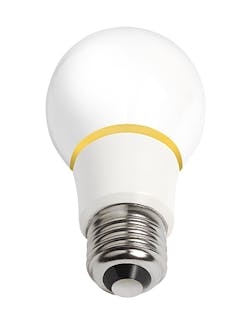The Finally Light Bulb Company has announced the induction-based Finally replacement lamp due this summer at a retail price below $8.00 for a 60W-equivalent product. The company claims that the lamp more closely mimics incandescent bulbs than do LED or compact-fluorescent (CFL) replacement lamps while still providing considerable energy savings and much longer life relative to legacy incandescent bulbs.
Finally calls their technology Acandescence, playing off the incandescent legacy. But while the company describes the approach as new and innovative, in reality the company is simply applying well-known induction technology in a light-bulb form factor.
Induction lighting is closely related to fluorescent technology. In both cases, electrodes stimulate a gas to produce ultraviolet (UV) light. In fluorescent lighting, the electrical energy is passed via conductors into the lamp. In induction lamps, the energy is magnetically coupled to electrodes that are electrically isolated inside the lamp. In either case, phosphor is required to convert the UV photons to usable light.
Induction sources
Induction lighting has been fairly broadly used in outdoor applications and in some industrial indoor applications. Induction has been described as generating a "blob of light," as we covered in an outdoor lighting article. That characteristic has meant that induction fixtures have found some success outdoors in applications such as post-top lighting for pedestrian-centric areas and less so in, say, street lighting where precise beam control is required.
A blob of light, however, can be good match for an application such as an omnidirectional bulb. Indeed, John Goscha, founder and CEO of the Finally Light Bulb Company, asserts that the induction design is the first incandescent alternative to accurately mimic the original in performance and form factor.
Goscha claims that consumers are generally dissatisfied with both CFL and LED lamps including what has become a complex buying process. He notes that some retailers have added concierges in the lighting department to help consumers choose a bulb. Goscha added, "I don’t think that you should have to rely on a concierge to buy a light bulb."
But will the Finally lamp really eliminate the need for consumers to be more educated in the light-bulb shopping process? Goscha said that consumers don’t want to know about CCT, CRI, or lumens.
Simplified shopping?
The Finally lamp has the inherent iconic shape of the Edison lamp without question and a nice omnidirectional beam distribution. Goscha is quick, however, to also tout the warm light produced by the lamp. But in the case of the induction lamps, CCT is a design choice just as it is with LED or CFL lamps. The 60W-equivalent lamp that Finally intends to ship this summer delivers 2700K CCT based on the phosphor used to coat the inner globe of the lamp. And as with LED and CFL lamps, such design choices impact other operational aspects such as the power consumption and the CRI of the lamp.
Moreover, the initial Finally product features a CRI of 83, according to Goscha. Incandescent lamps have a CRI of 100. The initial Finally lamp is also not dimmable. Lack of such a feature isn’t an indictment of the product as many LED and CFL lamps aren’t dimmable, but of the claim that consumers can choose a Finally lamp just as they did an incandescent which is inherently dimmable. Clearly, the Finally lamp is little different from CFL and LED products in that ultimately consumers will need to choose the features that they desire in a lamp.
Compare to LEDs
Still, the question remains as to how the Finally lamp compares to the top LED lamps on the market. The 60W-equivalent Finally lamp is most easily compared to the Cree 60W equivalent lamp. The Finally product delivers 800 lm from 14.5W. The Cree 2700K, 800-lm lamp consumes only 9.5W.
Finally was not willing to discuss the power consumption in detail. But generally induction technology lags LED in efficiency. Moreover, the induction technology requires a significant amount of red phosphor to deliver the red spectrum required for 2700K-CCT light. That red phosphor also generates energy in the infrared spectrum that is lost as heat. LEDs that use much smaller amounts of red phosphor suffer related but far lower losses. Indeed, the Cree TW (TrueWhite) model that delivers 93 CRI uses only 13.5W, still more efficient than the Finally lamp and higher CRI inherently impacts efficiency. Moreover, the Cree lamps are dimmable.
Price will gate sales
Still, the Finally replacement lamp could find a market if the price is right. The lamp is still 75% more efficient than incandescent lamps and projected to last 15,000 hours or 15 times longer than incandescent lamps. The energy efficiency and longevity trail LED lamps but would be more than acceptable in the residential space. Moreover, some consumers will surely choose the iconic look.
We will have to see if Finally can deliver the lamps in production and priced as promised. The 60W-equivalent lamp is due in July at $7.99 with 75W- and 100W-equivalent products due in the fall. Goscha said the company will leverage the incandescent bulb factories that have been shuttered due to lamp efficiency regulations and manufacture the products using the same globes as used in incandescent lamps, presumably resulting in prices below LED products.
The Finally lamps do undercut the market in list price significantly. Cree reduced prices in March but the 60W-equivalent product still sells for $10.97. The Philips Lighting SlimStyle lamp is under $10 but still 20% higher than the projected Finally price.
Without question, the Finally lamp is simper electronically than LED lamps. But the design will be more impacted by phosphor prices given that the dome must be fully coated. Note that the Chinese control of rare-earth elements used in phosphor resulted in a spike in fluorescent tube prices a few years back. But Goscha said the A19 lamps use much less phosphor than, say, a T8 tube. Goscha said the phosphor makes up a "single-digit percentage" of the bill of materials for the Finally lamp.
Goscha also said the company will deliver dimmable lamps down the road. He would not explain how such lamps will operate or when they will ship. But generally fluorescent and induction lighting have been severely limited in terms of fine-grain dimmability.






